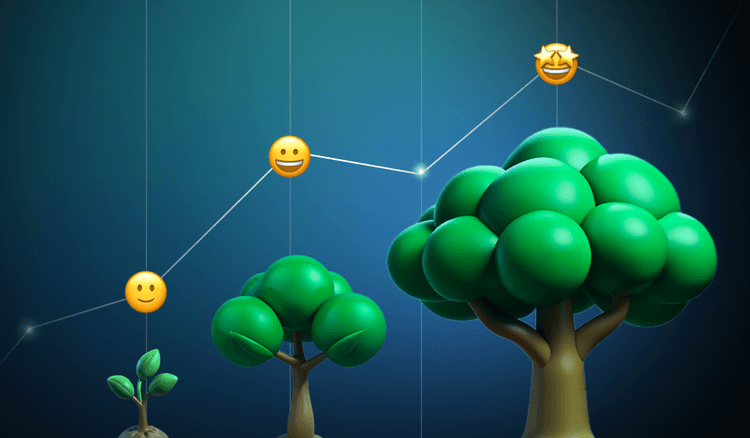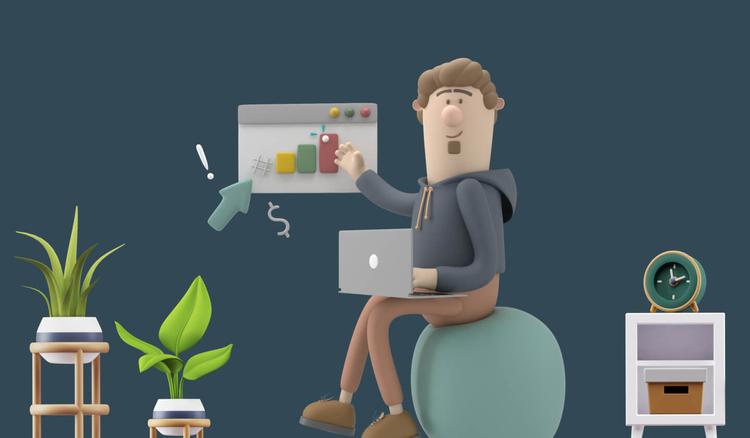When it comes to app development, most startups still face a dilemma: do we really need an MVP? Or can we just skip it and jump straight into building the full-scale product?
Our opinion on this matter is a resounding “no-no”. And nothing better proves the need for MVPs than the success stories that began as humble MVPs and grew into apps with worldwide fame.
So, if you're still unsure whether your project needs an MVP, keep reading. Today we are going to tell you about the most inspiring MPV examples in the world. By the time you finish this post, you might just find yourself convinced. Who knows, maybe your future app could follow in the footsteps of Uber or Tinder and become the next big thing.
Why do you have to build an MVP?
But before we head to minimum viable product examples, let us first highlight the perks that MVP development implies:
Focus on what matters most
- Fact: Most software products have about 80% of features that are hardly ever used.
When you prioritize the core features in your MVP, you ensure that development efforts are directed to what users truly need. Thus, you cut the app development cost and avoid wasting time on features that might be irrelevant. As a result, you deliver an impactful product that addresses key user pain points and provides value. Additionally, having a clear and defined MVP makes it easier to craft a comprehensive startup pitch deck and present your idea to investors.
Faster time-to-market
- Fact: Not all startups withstand the harsh competition – 10% of companies fail because they introduce their product to the market too late.
An MVP allows you to launch a basic version of your app quicker, gather user feedback, and iterate rapidly. Typically, MVP development spans from 2 to 6 months (the discovery phase included). It’s often 2x or even 3x times faster than launching a full-scale product. Thus, you gain a competitive edge by entering the market quickly, capturing early adopters, and securing your positions.
How long does it take to develop an app?
Read articleSaved money and resources
- Fact: 38% of startups fail because they run out of money and can’t raise new funds.
Building a smaller app is more cost-effective. By starting with an MVP, you minimize upfront investment and reduce the need for startup business loans and the financial risk associated with developing a full-scale version. This approach to resource allocation helps you to be more agile in the development process.
12 MVP examples: success stories
Now, it’s time to proceed with the most successful examples of various MVP types across industries:
MVP example #1: Netflix
📲 Industry: Entertainment
📍 Founded: 1997, Scotts Valley, California
💸 Monetization model: Subscription-based
Netflix's path to becoming a global streaming powerhouse wasn't a straight shot. It all began in 1997 with a much humbler MVP: a website for renting DVDs by mail. This service addressed customer’s pain points of late fees and due dates. Netflix prioritized convenience with features like subscriptions and a queue system, setting them apart from the competition.
However, its most disruptive move came in 2007 with the launch of its streaming service. By focusing on user experience and content quality, Netflix rapidly expanded its subscriber base and content library, revolutionizing how people access entertainment.
Today, with over 260 million subscribers worldwide, Netflix is synonymous with streaming excellence. The platform sets industry standards, with its original shows and personalized recommendations. From its MVP origins, Netflix has reshaped the entertainment landscape and become a cultural phenomenon.
MVP example #2: Airbnb
📲 Industry: Real estate
📍 Founded: 2008, San Francisco, California
💸 Monetization model: Service fees
Air Bed and Breakfast, later shortened to Airbnb, was founded in 2008 by Brian Chesky, Joe Gebbia, and Nathan Blecharczyk. It’s a nice minimum viable product example as it started as a platform connecting travelers with people who had spare air mattresses in their apartments.
This core concept addressed a need for affordable and unique travel experiences. The founders themselves even put an air mattress on their living room floor! This initial focus on a core function allowed them to test the market and gather valuable user feedback. As the platform gained traction, its founders expanded functionalities to include listings for entire apartments and homes and attract a wider range of hosts and guests.
Airbnb's success lies in its ability to adapt to user needs. They built trust through features like secure payment systems and reviews. Plus, the platform has always fostered a sense of community by encouraging interaction between hosts and guests. Thus, from accommodations on simple air mattresses, Airbnb transformed into a global hospitality giant, forever changing the way we travel the world.
How to Build an MVP: A Full Guide
Read articleMVP example #3: Instagram
📲 Industry: Entertainment, Social networking
📍 Founded: 2010, San Francisco, California
💸 Monetization model: Advertising
Instagram's evolution from a basic MVP example is a story of rapid growth and strategic innovation. Launched in 2010 by Kevin Systrom and Mike Krieger, Instagram began as a usual photo-sharing app focused on filters and easy editing tools.
This MVP was incredibly simple: users could take photos on their phones, apply filters, and share moments from their daily lives with a limited network. This focus on a single, well-defined function resonated with early adopters who wanted a more visual way to connect.
As Instagram became more and more popular, it continuously integrated new features, introducing video sharing platform, stories, and more. One particularly engaging format that emerged is the Instagram carousel, allowing users to share multiple images or videos in a single post. This feature not only enhanced user engagement but also transformed how brands showcase their products and tell stories. In 2012, Facebook acquired Instagram, further accelerating its growth.
Today, Instagram boasts over a billion monthly active users, making it one of the most influential social media platforms globally. And, let’s be honest, now we can hardly imagine how we connect, share, and discover content without Instagram.
Start your MVP journey with SolveIt!
Contact usMVP example #4: Uber
📲 Industry: Transportation
📍 Founded: 2011, San Francisco, California
💸 Monetization model: Service fees
Founded by Travis Kalanick and Garrett Camp, Uber started as a ride-hailing app that connected passengers with drivers for on-demand transportation. This minimum viable product example, initially called UberCab, was first publicly launched in San Francisco in 2011 and allowed users to order a black luxury car.
Gradually, Uber’s MVP expanded its services to include various ride options, such as UberX, UberPOOL, and UberBLACK, catering to different preferences and budgets. They also implemented features like real-time fare estimates, in-app payments, and driver tracking for transparency and user safety.
Through strategic partnerships and a focus on user experience, Uber revolutionized transportation. Today, Uber operates in hundreds of cities worldwide, reshaping urban mobility for millions of people.
MVP example #5: Duolingo
📲 Industry: Education
📍 Founded: 2011, Pittsburg, Pennsylvania
💸 Monetization model: Freemium business model
Duolingo is another great minimum viable product example that became a global phenomenon. Duolingo was initially launched in 2011 as a free language-learning website and mobile app. The MVP focused on providing users with an interactive platform to learn languages at their own pace. The gamified approach proved highly motivating, keeping users engaged and coming back for more.
Since this approach was beyond successful, Duolingo continuously introduced new features to enhance learning effectiveness, such as personalized lessons, progress tracking, and social features. Plus, the app has significantly amplified its list of languages – now it offers 40+ languages to choose from.
Today, Duolingo boasts over 500 million users, empowering individuals to learn new languages conveniently and affordably.
PoC vs. MVP vs. prototype: what is the difference?
Read articleMVP example #6: Spotify
📲 Industry: Music, Entertainment
📍 Founded: 2006, Stockholm, Sweden
💸 Monetization model: Freemium, Premium subscriptions
Spotify’s story began in 2008. Daniel Ek and Martin Lorentzon saw a global market demand for access to a vast library of music without downloading songs to a device and launched a music streaming service Spotify. Its initial international launches were limited to a few countries, including the UK and the US.
This example of MVP was a desktop application that allowed users to listen to a curated library of music for free, supported by occasional ads. This core function addressed the desire for a legal and convenient way to stream music. Later on, Spotify went mobile and was complemented with a premium subscription offering ad-free listening, on-demand playback, and offline downloads.
Spotify managed to find a balance between a freemium model and user needs. The company constantly expands its music library, introduces features like personalized playlists and podcasts, and integrates social elements for sharing.
MVP example #7: YouTube
📲 Industry: Video Sharing, Entertainment
📍 Founded: 2005, San Mateo, California
💸 Monetization model: Advertising, Premium subscriptions (YouTube Premium)
YouTube was founded in 2005 by three former PayPal employees: Steve Chen, Chad Hurley, and Jawed Karim. Their frustration with the complexities of online video sharing sparked the idea for YouTube. The founders aimed to create a platform where users could effortlessly upload, watch, and share videos with a global audience.
The core MVP function included uploading videos and sharing them with the world. The debut video uploaded to YouTube was "Me at the Zoo," featuring co-founder Jawed Karim at the San Diego Zoo. This simple yet iconic video marked the beginning of YouTube's journey.
With a staggering 2.7 billion active users every month, YouTube has become part of our digital lives. It's no longer just a place to catch up on funny cat videos or the latest music releases. It's a dynamic platform where people can build their social media careers, supported by detailed youtube channel statistics that help them analyze performance, engagement, and growth over time.
MVP example #8: Pinterest
📲 Industry: Social Media, Content Sharing
📍 Founded: 2010, Palo Alto, California
💸 Monetization model: Advertising, Premium features
Pinterest’s MVP was launched in 2010 as a digital pinboard for users to discover and save ideas for various interests and hobbies. This minimum viable product example was focused on providing an intuitive platform to share inspiration.
The platform grew rapidly and expanded its features to include rich pins, guided search, and group boards, enhancing user experience and driving engagement. Also, the platform announced a video ads product "Pinterest Premiere" in 2021 and a video streaming app “Pinterest TV Studio” in 2022.
Through strategic partnerships and community-building efforts, Pinterest evolved into a go-to destination for discovering new ideas, recipes, fashion trends, and more. Today, Pinterest has over 450 million monthly active users and remains a leading hub for visual discovery.
MVP example #9: WhatsApp
📲 Industry: Messaging, Communication
📍 Founded: 2009, Mountain View, California
💸 Monetization model: Subscription fees, Advertising
One more minimum viable product example that made a hit is WhatsApp. This messaging giant's journey began in 2009, and its concept originated as an app designed to show a contact’s status update, indicating whether a person was at work or on a call.
This feature was meant to help people communicate more efficiently by providing real-time information about their availability. However, WhatsApp founders realized the potential for a messaging platform that could work across different mobile operating systems and help users send messages without incurring SMS charges. This idea turned WhatsApp into the widely-used messaging app we know today.
As the user base grew, they introduced features like group chats, voice messaging, and file sharing, all leveraging Internet connectivity for a seamless experience. In 2014, Facebook acquired WhatsApp, further accelerating its growth and integration into the social media ecosystem.
MVP example #10: Slack
📲 Industry: Messaging, Communication
📍 Founded: 2009, Vancouver, British Columbia
💸 Monetization model: Freemium, Premium subscriptions
In fact, this minimum viable product example might never have reached the market if another product had not turned out to be unprofitable. How so? Slack began as an internal tool used by a gaming company called Tiny Speck. In other words, Slack’s MVP was developed to just address the team's specific needs.
The company was working on another product – a multiplayer online game called Glitch, but the game failed to gain traction in the market. Thus, the company changed its direction and focused on building a standalone communication platform.
In 2013, Slack was officially launched to the public as a messaging app for teams, offering features such as channels, direct messaging, file sharing, and integrations with other productivity tools. Over time, Slack continued to evolve based on market demands, eventually becoming the widely used team collaboration platform.
MVP example #11: Tinder
📲 Industry: Dating, Social Networking
📍 Founded: 2012, West Hollywood, California
💸 Monetization model: Subscription fees, Freemium, Advertising
Tinder's example of MVP was demonstrated in 2012 at a hackathon in West Hollywood. Sean Rad and Joe Munoz, recognizing the growing importance of mobile devices, built an app named "MatchBox" with a focus on photo-driven profiles and a swipe mechanic.
This initial concept, later renamed Tinder, targeted a young, tech-savvy audience with a gamified approach to online dating compared to traditional websites. The launch on college campuses fueled early user growth.
Today, Tinder is one of the world's most popular dating apps, with more than 75 million monthly active users. The app successfully connects millions of people around the globe, operating in over 190 countries and being accessible in 40+ languages.
How SexTech is redefining well-being: is it time to invest?
Read articleMVP example #12: Buffer
📲 Industry: Social Media Management
📍 Founded: 2010, Birmingham, United Kingdom
💸 Monetization model: Freemium, Premium subscriptions
In 2010, Buffer began as a simple solution to a common problem: managing social media posting efficiently. Frustrated with social media scheduling tools, Joel Gascoigne built an MVP of Buffer in about 7 weeks. This early version focused solely on scheduling tweets.
Despite its simplicity, it became popular among users who valued convenience. Buffer prioritized user feedback from the start, using it to guide the addition of features, support for more platforms, and valuable analytics.
Gradually, Buffer evolved from a basic scheduling tool into a comprehensive social media management platform. Now the platform supports 10+ social media channels, including dedicated LinkedIn scheduling tools for example, and helps individuals and businesses worldwide to engage with their audience effectively.
How long does it take to build an MVP [SolveIt Experience]
In general, MVP development lasts from 2 to 6 months including the discovery phase. The time-to-market strongly depends on the development approach, team expertise and complexity of the product. These timelines allow our customers to get the fully-fledged product into users' hands quickly, gather feedback, and incrementally enhance the offering.
By concentrating on the essential user value first, the clients are able to validate the concept, refine the product vision, and make data-driven decisions about future roadmap priorities - all while sustaining a fast time-to-market. Also, having a working, ready-to-use product according to this concept is much more likely to attract investors, which can establish a fundraising stream for development of further product's iterations.
Car Parking App MVP in 2.5 Months
The client approached SolveIt to create a smart urban app that would improve private parking management and make the experience more convenient and eco-friendly for car owners and operators. SolveIt conducted a discovery phase to define the app's concept and features, then provided clickable prototypes for both user and operator apps.
Within 2.5 months, SolveIt developed a fully functional MVP iOS app. This allowed car owners to find parking spots, pay contactless, and get location reminders. For operators, the app reduced paper usage and streamlined services. The MVP served as a proof-of-concept that helped the client secure funding to further develop and expand the solution.
Job Search App MVP in 3 Months
JobJob, the top employment platform, recognized that their mobile app had become outdated. Rather than updating the existing solution, they decided to take a more strategic approach: SolveIt's goal was to design a new, scalable, user-friendly job search app integrated with the client's backend. To achieve it, the discovery phase was initiated.
In just 3 months, SolveIt delivered the first MVP version, with a focus on intuitive UI/UX. The new app, built with our Flutter app development services, was launched on iOS and Android. By providing a high-quality MVP in a short timeframe, SolveIt helped the client modernize their platform and better serve job seekers and employers. This laid the foundation for further app enhancements to maintain JobJob.md's position as the leading job search resource in the region.
Final thoughts
We hope that these 12 minimum viable product examples will ignite your entrepreneurial spirit and inspire you to begin your own endeavor. Remember, starting small doesn’t mean that your product won’t shine bright later. After all, even the most iconic apps sometimes start with nothing but air mattresses!
If you have an innovative idea but don’t know how to bring it to life, consider opting for MVP development services. At SolveIt, we’ll be happy to discuss your vision and launch your MVP together.

![Top MVP development companies for startups in 2025 [rates included!]](/_next/image?url=https%3A%2F%2Fsolveit.dev%2Frails%2Factive_storage%2Fblobs%2FeyJfcmFpbHMiOnsibWVzc2FnZSI6IkJBaHBBaW9HIiwiZXhwIjpudWxsLCJwdXIiOiJibG9iX2lkIn19--724d41ec2bff5fd601e4b5c8fb17a46a7a081748%2FMVP_development_companies_1.png&w=750&q=75)

